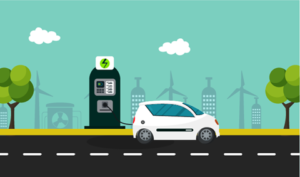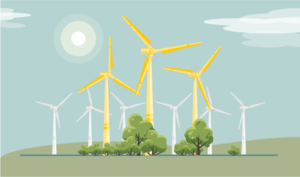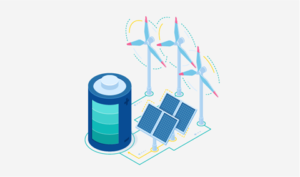The ‘green energy revolution is well and truly into overdrive across the world. As awareness about environmental degradation and the need to protect the ecosystem is growing, the demand for sustainable, renewable energy applications is going up. This year, the renewable electricity generation sector is projected to grow at ~9% – the fastest YoY growth in more than four decades.
With its excellent electrical and heat conductivity, robust physical properties, and top-class efficiency, copper has always been right at the heart of a wide range of electrical applications. In particular, enameled copper wire has found widespread adoption in both industrial and residential electronic appliances. The extremely high energy-efficiency rating of copper makes it ideal for usage in renewables as well. Often dubbed as the ‘metal of the future’, the worldwide demand for copper is expected to touch 5.5 million tons by the end of 2030.
Several significant trends have emerged regarding the application and usability of enameled copper wire and conductors in high-utility renewable energy applications. A few of these trends have been highlighted here:
Copper in the Electric Vehicle (EV) Sector

The market for EVs in India is expanding at very high rates, in sync with the global trends in this sector. By 2026, the Indian EV market is expected to have a valuation of more than $46 billion (with the CAGR for the 2021-2026 period being almost 45%).
The total copper content in EVs is considerably more than that in traditional vehicles. While the average internal combustion engine needs around 48 pounds of copper, the corresponding requirement goes up to nearly 90 pounds in hybrid electric vehicles, and 180+ pounds in battery-powered vehicles. These figures clearly indicate escalating demand for enameled copper wire for EVs in the foreseeable future.
The performance of EVs critically hinges on the energy-efficient motors they are powered by. These motor coils are heavily dependent on the quality of the copper magnet wires used. In addition, copper wires are also being used for cabling at EV charging stations.
As the worldwide EV market is evolving, more vehicle varieties are being designed. That, in turn, is set to disrupt the global copper demand levels as well. By 2027, the cumulative copper requirement for EVs is set to zoom past 1680 kilotons.
With EVs becoming more and more ubiquitous, we are definitely moving towards a cleaner, greener and more energy-efficient ecosystem. Copper wires, with their longevity, conductivity and overall reliability, are integral components in the motors of these vehicles.
Copper in Solar Power Industry

Installation of solar photovoltaic (PV) panels in industrial and commercial sectors is rapidly gaining in momentum. Since these applications do not cause carbon emissions or any other toxic wastes, their popularity is skyrocketing.
The top-notch electrical conductivity of enameled copper wires, together with their easy solderability, mechanical toughness, and aqueous/atmospheric corrosion resistance, makes them the ideal choice in these solar panels. The magnet wires are used to keep the solar cells separated, and ensure secure, loss-less conduction of electricity from the cells to solar inverters. The maximum current that can be transferred in this manner varies with the width/size of the wires.
With robust YoY increases in installed photovoltaic capacity, opportunities for manufacturers of enameled copper wires for solar panels are expanding fast. These wires can be used for all wiring, cabling and heat exchanger requirements.
Solar technology is highly mineral-intensive – and that reflects in the use of copper in this sector. On average, solar energy systems use up close to 5.5 tons per MW of copper. The growth of the solar power industry is further being boosted by the falling installation costs (over the last ten years or so, installation costs have fallen by 10%).
In the United States alone, there will be 260+ GW new solar installations by 2027. This, in turn, will pull up the demand for copper to just a shade under 2 billion pounds.
Copper for Wind Farms

Across the globe, wind turbines are fast emerging as one of the most environment-friendly renewable energy applications. Investments in large-scale wind power projects are escalating, as a direct result. In India, the total wind power generation capacity is expected to touch 60 GW by the end of 2022.
Both off-shore, as well as on-shore wind farms, are highly copper-intensive – with the former being particularly so (while on-shore farms require around 7800 pounds of copper per MW, the corresponding figure is more than 21000 pounds per MW for off-shore farms). Enameled copper wires are being used in different wind turbine parts and applications. Apart from wiring and cabling, these insulated copper conductors are also used in turbine transformers & motors, power generation units, earthing/lightning protection units, and other key components.
The suitability of copper for extensive usage in wind farms is beyond all possible doubts. Typically, wind turbines are regularly exposed to harsh atmospheric conditions. Apart from being a powerful conductor, copper has the requisite flexibility, strength and durability to withstand such conditions – without any degradation of functionality.
An average 3 MW wind turbine can require more than 4.5 tons of copper. The importance of copper in advanced wind energy technologies is reflected in the surge in demand for enameled copper wires in wind farms.
Together, solar and wind energy applications have an enormous potential to fight the ill-effects of climate change. By 2050, these applications can restrict the increase in global temperature to sub-2°C levels. For that to happen, installed capacities of both solar PVs and off-shore/on-shore wind farms have to keep increasing steadily. The total copper content in these applications, as a result, will also go up significantly.
Copper in Smart Grids for Energy Storage

Smart grids, with built-in electronic hardware and automated software, are the future – as far as efficient energy storage is concerned. Not surprisingly, global investments on smart grids are growing at impressive rates. Modular switchgear – which are one of the key elements of these smart grids – are also being produced at scale.
The dramatic increase in installation and adoption of smart grid networks (with European markets leading the way) is set to pull up the overall demand for reliable and efficient enameled copper wires as well. In smart grids and the increasingly common microgrids, copper will be used extensively.
The key engineering properties of copper wires (e.g., durability, electrical conductivity, energy-ratings, etc.) do not diminish due to extended periods of usage. These wires are fully recyclable as well. These features make copper the ‘material of choice’ for smart grids.
Apart from being used in the modular switchgears, copper wires also come in handy in power collection from multiple distributed energy resources (DERs), creation of virtual power plants, electrical load management, and other key energy storage functions.
In addition to smart grids, copper has already proven its worth in different types of new-age energy storage technologies. Among these, the total copper content is the highest in flow batteries and compressed air energy storage (CAES) systems, followed by sodium batteries, flywheels, lithium ions, and others.
Key Challenges
The role of copper in general, and enameled copper wires in particular, in renewable energy applications, can hardly be overemphasised. However, the transition is still at a very early stage – and there are key challenges that have to be overcome.
With the total number of copper mines not growing in pace with the burgeoning demand levels, there is already a demand-supply mismatch in the global copper industry. A recent Citigroup report estimated that the supply deficit will be around 520,000 tons by the end of this year.
There has also been a general fall in the average copper ore grades. Copper production is becoming increasingly concentrated – and that is a point of concern. Going forward, new copper sources have to be found, in order to meet the escalating demands.
Looking Ahead
All noteworthy transitions are powered by new material requirements. The transition to a sustainable world is no exception – and copper is headlining this revolution. The yearly copper demand for solar and wind technologies is projected to go beyond 3 million tons by 2050.
Copper has emerged as by far the most critical material for renewables. The need for clean energy has never been higher – and copper plays a key role in the required transition.

